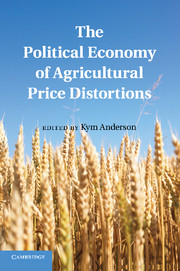Book contents
- Frontmatter
- Contents
- List of Figures
- List of Tables
- Contributors
- Foreword
- Preface
- Abbreviations and Acronyms
- PART ONE Introduction
- ONE Understanding Government Interventions in Agricultural Markets
- TWO Agricultural Distortion Patterns since the 1950s
- PART TWO CONCEPTUAL FRAMEWORKS AND HISTORICAL ORIGINS
- Part Three Political Econometrics: the Past Fifty Years
- Appendix: Coverage and Distribution of Assistance across Countries and Products, 1955–2007
- Index
- References
TWO - Agricultural Distortion Patterns since the 1950s
What Needs Explaining?
Published online by Cambridge University Press: 05 July 2011
- Frontmatter
- Contents
- List of Figures
- List of Tables
- Contributors
- Foreword
- Preface
- Abbreviations and Acronyms
- PART ONE Introduction
- ONE Understanding Government Interventions in Agricultural Markets
- TWO Agricultural Distortion Patterns since the 1950s
- PART TWO CONCEPTUAL FRAMEWORKS AND HISTORICAL ORIGINS
- Part Three Political Econometrics: the Past Fifty Years
- Appendix: Coverage and Distribution of Assistance across Countries and Products, 1955–2007
- Index
- References
Summary
Among the most important influences on the long-run economic growth and distribution of global welfare are trade-related policy developments in individual countries and their combined effect on other countries via the terms of trade in international markets. Some of the policy developments of the past half century have happened quite suddenly and been transformational. They include the end of colonization around 1960, the creation of the Common Agricultural Policy in Europe in 1962, the floating of exchange rates and associated liberalization, deregulation, privatization, and democratization in the mid-1980s in many countries, and the opening of China in 1979, Vietnam in 1986, and Eastern Europe following the fall of the Berlin Wall in 1989 and the demise of the Soviet Union in 1991. Less newsworthy and hence less noticed are the influences of policies that change only gradually in the course of economic development as comparative advantages evolve. This chapter is focused on summarizing a new database that sheds light on the combined impact of both types of trade-related policy developments over the past half century on distortions to agricultural incentives and thus also to consumer prices for food.
For advanced economies, the most commonly articulated reason for farm trade restrictions has been to protect domestic producers from import competition as they come under competitive pressure to shed labor as the economy grows.
- Type
- Chapter
- Information
- The Political Economy of Agricultural Price Distortions , pp. 25 - 78Publisher: Cambridge University PressPrint publication year: 2010
References
- 6
- Cited by



